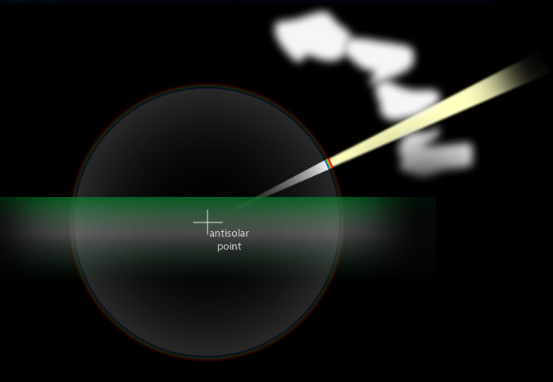Colour Patch, New Zealand - OPOD
Colour Patch, New Zealand - OPOD: A Closer Look at a Phenomenal Atmospheric Display
In the enchanting landscapes of New Zealand, a captivating atmospheric phenomenon known as the Colour Patch has been captured by the talented photographer Kimball Chen of Kea Photography. This mesmerizing image was taken in Invercargill, located at the southern tip of the South Island. Let's dive deeper into this stunning display of nature's wonders.
The focal point of the image is a vibrant rainbow-coloured patch, which is actually a thin segment of a primary rainbow. This phenomenon occurs when a small clearing or hole in the clouds allows a parallel shaft of sunlight to penetrate through. This shaft of sunlight behaves as a single antisolar ray, appearing to converge towards the antisolar point.
The antisolar point is where the rainbow's center is also located. When the shaft of sunlight intersects rain droplets along its path, a segment of the rainbow becomes visible. It's important to note that not all coloured patches are rainbows; their appearance depends on factors such as height above the horizon and the position of the sun.
The Colour Patch in New Zealand is just one example of the diverse atmospheric optics phenomena that can be observed worldwide. Let's explore some other breathtaking displays that may be encountered under different atmospheric conditions:
-
Circumhorizon Arc Fragment: Under specific circumstances, when the sun is high in the sky, you might witness fragments of a circumhorizon arc. This optical phenomenon appears as a colorful band running parallel to the horizon, caused by the refraction of sunlight through ice crystals in cirrus clouds.
-
Iridescent Cloud: If you're lucky enough to catch sight of an iridescent cloud, you'll be treated to a spectacle of shimmering colors. These clouds exhibit iridescence due to the diffraction and interference of light as it interacts with water droplets or ice crystals in the cloud.
-
Sundog: Also known as a parhelion, a sundog is a bright spot that appears on either side of the sun, often accompanied by a halo. Sundogs are formed when sunlight is refracted by ice crystals in the atmosphere, creating a stunning display of colorful patches of light.
These incredible atmospheric displays serve as a reminder of the immense beauty and complexity of our natural world. While the Colour Patch in New Zealand is truly awe-inspiring, it is just one piece of the puzzle in the vast realm of atmospheric optics.
As we delve deeper into understanding these phenomena, scientists continue to unravel the intricate processes that contribute to their formation. The study of atmospheric optics allows us to gain insights into the behavior of light in our atmosphere and provides valuable information for various scientific fields, including meteorology, astronomy, and climate science.
Photographers like Kimball Chen play a crucial role in capturing these fleeting moments of atmospheric brilliance, allowing us to appreciate and study these phenomena long after they disappear from the sky. Through their lens, we can explore the intricacies of light and color, and marvel at the wonders that unfold above us.
So, next time you find yourself gazing up at the sky, keep an eye out for the mesmerizing Colour Patch or any other atmospheric optics phenomena. You never know what captivating display nature has in store for you. Embrace the magic of the natural world and let it inspire you to explore further, both with your eyes and your imagination.

Colour Patches ~ Imaged by Kimball Chen ( Kea Photography ) at Invercargill at the southern tip of the South Island of New Zealand. Image ©Kimball Chen, shown with permission

The rainbow coloured patch is a thin segment of a primary rainbow.
A small clearing or hole in clouds gives a parallel shaft of sunlight. The shaft behaves as a single antisolar ray that appears by perspective to converge towards the antisolar point.
The rainbow's centre is also at the antisolar point. If the shaft of sunlight happens to intersect rain then we get a rainbow segment.
Not all coloured patches are rainbows. Depending on height above the horizon and position of the sun they could be a circumhorizon arc fragment, a small iridescent cloud, a sundog and more..
Note: this article has been automatically converted from the old site and may not appear as intended. You can find the original article here.
Reference Atmospheric Optics
If you use any of the definitions, information, or data presented on Atmospheric Optics, please copy the link or reference below to properly credit us as the reference source. Thank you!
-
<a href="https://atoptics.co.uk/blog/colour-patch-new-zealand-opod/">Colour Patch, New Zealand - OPOD</a>
-
"Colour Patch, New Zealand - OPOD". Atmospheric Optics. Accessed on April 24, 2024. https://atoptics.co.uk/blog/colour-patch-new-zealand-opod/.
-
"Colour Patch, New Zealand - OPOD". Atmospheric Optics, https://atoptics.co.uk/blog/colour-patch-new-zealand-opod/. Accessed 24 April, 2024
-
Colour Patch, New Zealand - OPOD. Atmospheric Optics. Retrieved from https://atoptics.co.uk/blog/colour-patch-new-zealand-opod/.